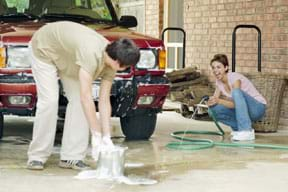Quick Look
Grade Level: 6 (5-7)
Time Required: 1 hour
Expendable Cost/Group: US $0.00
Group Size: 1
Activity Dependency:
Subject Areas: Earth and Space, Measurement, Science and Technology
NGSS Performance Expectations:

| MS-ESS3-4 |

Summary
Students keep track of their own water usage for one week, gaining an understanding of how much water is used for various everyday activities. They relate their own water usages to the average residents of imaginary Thirsty County, and calculate the necessary water capacity of a dam that would provide residential water to the community.Engineering Connection
When designing dams and water supply infrastructure, civil engineers and planners must understand how much demand must be met with the design. Residential domestic use comprises a significant portion of the design load. Accurate estimates of per capita water usage are important so that engineers do not over- or under-design a dam, especially because dam design, construction and oversight are expensive.
Learning Objectives
After this activity, students should be able to:
- Calculate volume of water used on a daily and weekly rate.
- Explain ways to limit their own water usage.
- Know an average water usage rate for one person in a home.
Educational Standards
Each TeachEngineering lesson or activity is correlated to one or more K-12 science,
technology, engineering or math (STEM) educational standards.
All 100,000+ K-12 STEM standards covered in TeachEngineering are collected, maintained and packaged by the Achievement Standards Network (ASN),
a project of D2L (www.achievementstandards.org).
In the ASN, standards are hierarchically structured: first by source; e.g., by state; within source by type; e.g., science or mathematics;
within type by subtype, then by grade, etc.
Each TeachEngineering lesson or activity is correlated to one or more K-12 science, technology, engineering or math (STEM) educational standards.
All 100,000+ K-12 STEM standards covered in TeachEngineering are collected, maintained and packaged by the Achievement Standards Network (ASN), a project of D2L (www.achievementstandards.org).
In the ASN, standards are hierarchically structured: first by source; e.g., by state; within source by type; e.g., science or mathematics; within type by subtype, then by grade, etc.
NGSS: Next Generation Science Standards - Science
| NGSS Performance Expectation | ||
|---|---|---|
|
MS-ESS3-4. Construct an argument supported by evidence for how increases in human population and per-capita consumption of natural resources impact Earth's systems. (Grades 6 - 8) Do you agree with this alignment? |
||
| Click to view other curriculum aligned to this Performance Expectation | ||
| This activity focuses on the following Three Dimensional Learning aspects of NGSS: | ||
| Science & Engineering Practices | Disciplinary Core Ideas | Crosscutting Concepts |
| Construct an oral and written argument supported by empirical evidence and scientific reasoning to support or refute an explanation or a model for a phenomenon or a solution to a problem. Alignment agreement: | Typically as human populations and per-capita consumption of natural resources increase, so do the negative impacts on Earth unless the activities and technologies involved are engineered otherwise. Alignment agreement: | Cause and effect relationships may be used to predict phenomena in natural or designed systems. Alignment agreement: All human activity draws on natural resources and has both short and long-term consequences, positive as well as negative, for the health of people and the natural environment.Alignment agreement: Scientific knowledge can describe the consequences of actions but does not necessarily prescribe the decisions that society takes.Alignment agreement: |
Common Core State Standards - Math
-
Use ratio reasoning to convert measurement units; manipulate and transform units appropriately when multiplying or dividing quantities.
(Grade
6)
More Details
Do you agree with this alignment?
-
Fluently divide multi-digit numbers using the standard algorithm.
(Grade
6)
More Details
Do you agree with this alignment?
-
Display numerical data in plots on a number line, including dot plots, histograms, and box plots.
(Grade
6)
More Details
Do you agree with this alignment?
-
Fluently add, subtract, multiply, and divide multi-digit decimals using the standard algorithm for each operation.
(Grade
6)
More Details
Do you agree with this alignment?
International Technology and Engineering Educators Association - Technology
-
Analyze how an invention or innovation was influenced by its historical context.
(Grades
6 -
8)
More Details
Do you agree with this alignment?
State Standards
Colorado - Math
-
Use the four operations to solve word problems involving distances, intervals of time, liquid volumes, masses of objects, and money, including problems involving simple fractions or decimals, and problems that require expressing measurements given in a larger unit in terms of a smaller unit.
(Grade
4)
More Details
Do you agree with this alignment?
-
Use ratio and rate reasoning to solve real-world and mathematical problems.
(Grade
6)
More Details
Do you agree with this alignment?
Colorado - Science
-
Use tools to gather, view, analyze, and report results for scientific investigations about the relationships among mass, weight, volume, and density
(Grade
6)
More Details
Do you agree with this alignment?
Materials List
Each student needs:
- Personal Water Use Chart
- pencil
- calculator
Worksheets and Attachments
Visit [www.teachengineering.org/activities/view/cub_dams_lesson01_activity1] to print or download.Pre-Req Knowledge
Ability to add, multiply, divide and calculate averages.
Introduction/Motivation
Remember our imaginary place – Thirsty County? What were some of the water-related complaints of many residents? (Answers: Not enough domestic water for people in the dry summers, farmers unable to grow crops without enough irrigation water, Birdseye River not deep enough during dry months to transport cargo to people, flash floods ruining homes, air pollution from a coal power plant.) Today let's focus on one of those complaints: Not enough water for household use. Domestic water use includes water for drinking, cooking, bathing, washing, and lawn and garden watering. When we design the dams for Thirsty County, how can we know if we are planning for enough water for household use? Well, we start by estimating how much water its citizens use. Based on that estimate, we design a dam that is not too small to provide that much water, but not so big that it is too expensive.
How do we create a water use estimate for Thirsty County residents? Do you think that Thirsty County citizens probably use water in the same ways that we do? Starting today, we are all going to keep track of how much water we use every day. Then, we can combine everyone's data to get a class average, and we will consider that number to be the average water use for one person. We can use this information to create an estimate of the residential water usage of Thirsty County, and then we will be ready to move on with the dam design!
Procedure
Before the Activity
• Gather materials and make copies of the Personal Water Use Chart.
With the Students: Data Collection Instructions
Hand out the chart and explain to students how to use it.
- Count the number of times you do each activity in one day, and write that number in the box for that day. Using tallies is the best way to keep track.
- Ask an adult in your household whether you have standard or low-flow showerheads and toilets. If you are not sure, assume a standard flow.
- For activities that other members in your family might be doing for the household (go through the list to talk about which ones those might be, such as cooking a meal, doing dishes or laundry, etc.), count the number of times anyone in your family does one of those activities in a day, and then divide that total by the number of people in the household to count your portion of that water usage.
- If your household has an automatic lawn watering system, find out the schedule so you do not forget to include that water usage.
- Also, only count the water that you use at home, and not at school or elsewhere.

How much water do you use every day?
Have students use the chart for one week, reminding them each day to fill it in. You might suggest they hang it on their refrigerator at home.
With the Students: Data Calculation
- Mid-week, conduct a preliminary calculation and class discussion, as described in the Assessment section.
- At the end of the week, have students fill in the Total Number of Times column by adding across each row to get the total number for each activity.
- Have students calculate the water usage for each activity by multiplying the Total Number of Times column by the Estimated Amount of Water Used column.
- Have students add together the numbers in the Total Weekly Water Use column to get their Total Weekly Water Use.
- Ask each student to write his/her Total Weekly Water Use number on the board.
- As a class, take the average of those numbers. Tell the students that they can assume that an average person in Thirsty County uses about that same amount of water in one week.
- As a class, divide the average by 7 to get a daily amount of water.
- As a class, figure out how much water is needed daily by the entire Thirsty County, which has one million residents, by multiplying the average daily use by 1,000,000.
- Conclude with a class discussion. See the post-activity assessment questions provided in the Assessment section.
Vocabulary/Definitions
dam: A barrier to obstruct the flow of water, especially one made of earth, rock, masonry and/or concrete, built across a stream or river.
domestic: Of or pertaining to the home, the household, household affairs, or the family.
engineer: A person who applies her/his understanding of science and math to creating things for the benefit of humanity and our world.
municipality: A political unit, such as a county, city, town or village, incorporated for local self-government.
reservoir: A place where water is stored, often created by a dam.
residential: Of or pertaining to residence or to residences (homes, households).
tally: A mark made to record a number or count, often consisting of four consecutive vertical lines with a diagonal line through them to indicate a group of five.
Assessment
Pre-Activity Assessment

Estimation: Have the students look at a gallon container to help them make the following estimations. Encourage them to play with filling the gallon jug with water to help them imagine and estimate. Ask the students: How many gallons of water do you think you use to:
- Wash your hands?
- Brush your teeth?
- Take a shower?
- Take a bath?
- Flush the toilet?
- Get a drink?
- Wash the dishes?
- Water the lawn?
- Wash the car?
Activity Embedded Assessment
Mid-Week Calculation: After two or three days of data collection, ask students to calculate their total water usage so far. Have them use a separate piece of paper and follow the same steps outlined in the Procedure section. Have all the students write their numbers on the board, and then do the following with the students:
- What is the average?
- What is the lowest number? Is there a particular reason why it is so low?
- What is the highest number? Is there a particular reason why it might be so high?
- What might you do to lower your water usage? (Possible answers: Switch to low-flow showerheads/toilets, turn off water while brushing teeth, only run the dishwasher when it is full, use a spray nozzle to stop the hose from running while washing the car, etc.)
Post-Activity Assessment
Graphing: Have students create a pie chart describing what activities make up their total weekly usage of water. Which activities tended to use the most water? The least?
Discussion Questions: Have students answer the following questions by raising their hands.
- We counted the water usage in our homes, or for residential buildings. For what other kinds of buildings must engineers include when determining a municipality's estimated total water usage? (Possible answers: Schools, businesses, factories, power plants, farming irrigation, roadside irrigation, storage for drought season, fire protection, swimming pools, recreation/ball field irrigation, etc.)
- Say an engineer calculates the average water use for all buildings in a county, and then designs a dam to provide that exact amount of water. Is there always enough water for the residents to use? (Answer: Not necessarily; since the design is based on an average, sometimes the county might use more water than provided. Engineers almost always "over-design" to provide a little extra water, just in case.)
Troubleshooting Tips
Have students double check their calculations. It is easy to make a mistake!
Activity Extensions
Add your classroom's data to CIESE's international database of student water usage at http://www.ciese.org/
Activity Scaling
- For lower grades, help students with calculations such as multiplication, division, summing and averaging.
- Ask more advanced students to figure out how large the dam of Thirsty County would need to be in order to meet its residents' water needs. For example, if each resident uses 50 gallons per day, the annual water usage (for the one million residents) is 50,000,000 gallons. If one gallon of water fills approximately 0.0038 cubic meters, the dam must be at least 190,000 cubic meters in volume (50,000,000 gallons x 0.0038 cubic meters / gallon = 190,000 gallons).
- Ask more advanced students to refine their personal water usage by measuring the amount of water used (not just how many times) and modify the amounts in the Estimated Amount of Water Used column to be more exact. Also have them add other residential water usage items that were not on the list (if any).
Subscribe
Get the inside scoop on all things TeachEngineering such as new site features, curriculum updates, video releases, and more by signing up for our newsletter!More Curriculum Like This

Students are introduced to the concept of a dam and its potential benefits, which include water supply, electricity generation, flood control, recreation and irrigation. This lesson begins an ongoing classroom scenario in which student engineering teams working for the Splash Engineering firm design...
References
Dictionary.com. Lexico Publishing Group, LLC., http://www.dictionary.com, accessed December 4, 2007. (Source of some vocabulary definitions, with some adaptation)
Down the Drain. 2005. Center for Improved Engineering and Science Education (CIESE), Stevens Institutes of Technology. Accessed December 4, 2007. http://www.ciese.org/
Water Science for Schools: Water Questions and Answers: Water Use at Home. Last modified August 30, 2005. US Geological Survey. Accessed December 4, 2007. http://ga.water.usgs.gov/
Copyright
© 2008 by Regents of the University of Colorado.Contributors
Megan Podlogar; Tom Rutkowski; Sara Born; Kristin Field; Denali Lander; Denise W. CarlsonSupporting Program
Integrated Teaching and Learning Program, College of Engineering, University of Colorado BoulderAcknowledgements
The contents of this digital library curriculum were developed under a grant from the Fund for the Improvement of Postsecondary Education (FIPSE), U.S. Department of Education and National Science Foundation GK-12 grant no. 0338326. However, these contents do not necessarily represent the policies of the Department of Education or National Science Foundation, and you should not assume endorsement by the federal government.
Last modified: February 22, 2018






User Comments & Tips